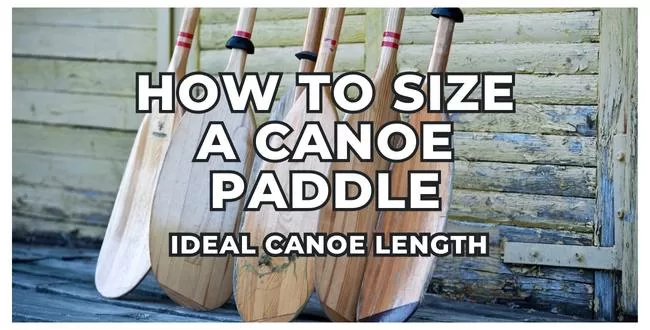A canoe paddle’s size and kind significantly impact the experience. When getting on the water, people like to be fully prepared before realizing they require the proper size and type of canoe paddle. Making the improper canoe paddle work results in wasted effort and frustration.
If you wind up with a too-short paddle, you’ll lean further over the edge of the boat, possibly scraping the gunwale, which can cause you to lose your balance and strain your body’s endurance.
On the other hand, an excessively long paddle may cause you to experience more resistance with each stroke and make it difficult to raise the canoe blade out of the water fully. You can go through the water more quickly and have a more enjoyable experience if you are at ease with your paddling set-up.
The ideal length for a straight canoe paddle is between 52 and 60 inches. Given that the blades of bent-shaft canoe paddles are shorter and wider, they should be between 48 and 52 inches long. The most popular lengths for canoe paddles are 57″, 60″, and 54″. Typically, canoe paddles come in length increments of 3 or 2 inches.
Key Takeaways On Best Canoe Paddle Length
Average Canoe Paddle Length – The boat’s breadth and the paddler’s height are two variables that can affect the average length of a canoe paddle.
However, the standard range for straight canoe paddles is 52″ to 60″. Due to their shorter and wider blades, bent-shaft paddles are typically shorter (48″ to 54″).
Does My Height Influence The Paddle Length I Should Choose – When selecting a paddle length, your height should be taken into account. According to most size methods, the paddle should be 6 inches shorter than your height.
The bridge of your nose, or six inches less than your height, should be the optimum length for a classic wooden paddle for the stern paddler.
What Size Canoe Paddle Do I Need?
Here is how you can decide on what size canoe paddle you need:
Canoe Paddle Length:
The majority of canoers need a paddle that is 52″ to 60″, with sizes commonly available in 2″ increments.
Due to their shorter and wider construction, bent-shaft canoe paddles should be between 48″ and 52″ long. In contrast, straight canoe paddles should be between 52″ and 60″ long.
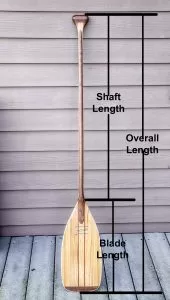
Seat Height:
The length of the paddle you need may also depend on the height of your canoe seat. As a general guideline, select the shortest paddle to reach the water effectively.
Canoe Width:
The length of your paddle may also depend on how wide your canoe is. Choose a paddle with a shorter shaft (usually one size) for narrow tripping canoes, those with tumblehome (inward tilting) gunwales, or low seats. Longer paddles might be necessary for extra-wide, flaring canoes.
Personal Preference:
Although many seasoned paddlers have a variety of paddle brands and sizes for various situations, the following chart works well for sizing beginning paddlers.
Your ideal paddle length will ultimately rely on your preferences and the kind of canoeing you intend to practice.
| Torso Size | Straught Shaft Paddle Length | Bent Shaft Paddle Length |
| Short Torso | 52”-56” | 50”-54 |
| Medium Torso | 56”-60” | 54”-58’ |
| Long Torso | 60”-64” | 58”-62” |
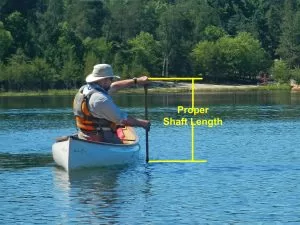
Canoe Paddle Size Chart
The table below will guide you on how long a canoe should be:
| Canoe Width | Paddler Height | Paddle Length |
| Under 35” | Under 5’5” | 240 cm |
| Under 35” | 5’6”-5’11” | 260 cm |
| Under 35” | 6” and above | 280 cm |
| 35” and longer | Under 35” | 240 cm |
| 35” and longer | 5’6”-5’11” | 260 cm |
| 35” and longer | 6” and above | 280 cm |
Factors on Which You Should Pick A Canoe Paddle and Its Length
Your size and strength:
Despite having more leverage with a longer paddle, your boat will require more power to move through the water. Picking a paddle that you find comfortable to use and that enables you to paddle with proper form is crucial.
Water conditions:
The type of water may also influence your choice of paddle you’ll be paddling in. A longer paddle, for instance, may be better for handling open water, while a shorter paddle is for controlling rapids or ideal for whitewater canoeing.
The make and feel:
Your experience on the water may also be impacted by the sort of paddle you select. While some paddlers favor a straight-shaft paddle, others prefer the feel of a bent-shaft canoe paddle.
Bent or straight shaft:
A bent-shaft canoe paddle should be between 48″ and 52″ long due to its shorter and wider construction, while a straight canoe paddle should be between 52″ and 60″ long.

On the water:
One way to choose the paddle length is to sit inside the canoe and measure the vertical distance from your nose to the waterline. The distance between the paddle’s grip and the throat, where the paddle shaft and blade meet, should be the same as this measurement.
In-store, trying out a paddle:
Keeping things like your boat’s width and seat height in mind when testing out paddles in stores is crucial. Paddle size selection is also influenced by the paddling you undertake.
A paddle with a shorter shaft might be more appropriate for small tripping canoes, those with inward-leaning gunwales, or those with low seats.
However, extra-wide, flaring canoes and those with high seats require a somewhat longer paddle to guarantee that you can reach the water with the blade without running into the shaft or banging your knuckles against the gunwale.
At home, without a paddle:
If you don’t have a paddle to measure with, you can consider the length suggestions made by professionals. The most popular canoe paddle lengths are 57″, 60″, and 54″. Lengths are available in increments of 3″ or 2″.
If you want more speed, Less Wrist Strain and Easier Maneuverability, all in one canoe paddle then you can also use kayak pedal for canoeing. They have double blade design but both the blades are relatively smaller compared to the canoe pedal.
Different Types of Water Flows and The Recommended Paddle Length For It
| Waterway | Paddle Lenght Range (Inches) |
| Whitewater/Rapids | 52-58 |
| Rivers and Streams | 54-60 |
| Lakes and FlatWater | 56-62 |
| Touring/Expedition | 57-63 |
| Canoe Camping | 58-64 |
| Racing Performance | 52-58 |
Pros and Cons of Shorter vs Longer Canoe Paddle
| Pros For Shorter Canoe Paddles | Cons For Shorter Canoe Paddles | Pros For Longer Canoe Paddles | Cons For Longer Canoe Paddles |
| Easier to control in tight spaces. | Less efficient for long-distance paddling. | More efficient for long-distance paddling. | Difficult to control in tight spaces. |
| More suitable for low-angle paddling style. | Less suitable for high-angled paddling. | More suitable for high-angled paddling. | Less suitable for low-angle paddling style. |
| More suitable for solo paddling. | Less suitable for tandem paddling. | More suitable for tandem paddling. | Less suitable for solo paddling. |
| Less expensive. | Less powerful strokes. | More powerful strokes. | More expensive. |
| Less arm fatigue. | Less reach and paddling. | More reach and paddling. | More arm fatigue. |
What is the Chair Method For Canoe Paddle Sizing?
The chair method for canoe paddle sizing is a simple and effective technique. Here is what you do in the chair method:
- Sit on a chair: Find a sturdy chair or bench and sit comfortably.
- Hold the paddle: Take the paddle and hold it as you would when paddling a canoe, with the grip in your hand and the blade facing away from you.
- Position the paddle: Place the paddle’s grip on the seat beside you, ensuring the blade points upwards and away from you.
- Measure to your chin: Measure the distance from the chair’s seat to your chin. This measurement represents the ideal shaft length of the paddle if your canoe were riding on top of the water.
- Add 6 inches: To determine the proper shaft length of a bent or straight shaft paddle, add 6 inches to the measurement you obtained in the previous step.
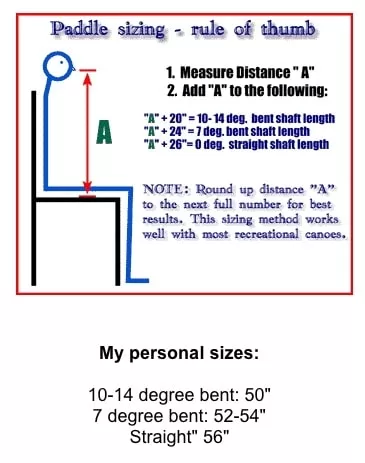
This additional length accounts for the depth of the water and provides a more suitable paddle length for effective paddling.
What features should I look for in a paddle?
Material: Similar to canoe material, the paddle’s weight, toughness, and performance can all be impacted by its substance. Composite canoe paddles of carbon, aramid, and fiberglass are incredibly robust and light.
These paddles are a popular option for racing and high-performance paddling because they don’t require periodic maintenance like wooden paddles.
Weight: The paddle’s weight can impact your comfort and stamina when paddling. Longer paddling sessions are possible with a lighter paddle since it helps with fatigue.
Functionality: The paddle’s intended application is referred to as its functionality. For instance, a paddle made for whitewater paddling will differ from one made for flatwater paddling in its attributes.
Blade: The performance and effectiveness of the paddle can be impacted by the blade’s size, shape, and angle. While a narrower blade can offer greater control, a wider blade can deliver more power.
Length: Your height, the width of your canoe or board, and your paddling technique should all be considered when choosing a paddle. While a shorter paddle can offer better control, a longer paddle may offer more leverage.
Shaft: The effectiveness and comfort of the paddle can be impacted by the shaft’s straightness or bend. A straight shaft can offer more adaptability and maneuverability, whereas a bent shaft can lessen wrist stress.
Understanding Structure of Canoe Paddle – All Parts
Grip
The grip is an important part of a canoe paddle and can greatly affect your comfort and control while paddling.
Palm grip:
The palm grip is the most typical grip on flatwater and recreational canoe paddles. The primary portion of your palm should rest comfortably on the grip.
This grip offers a natural, comfortable hand position for long-distance paddling and general recreational use.
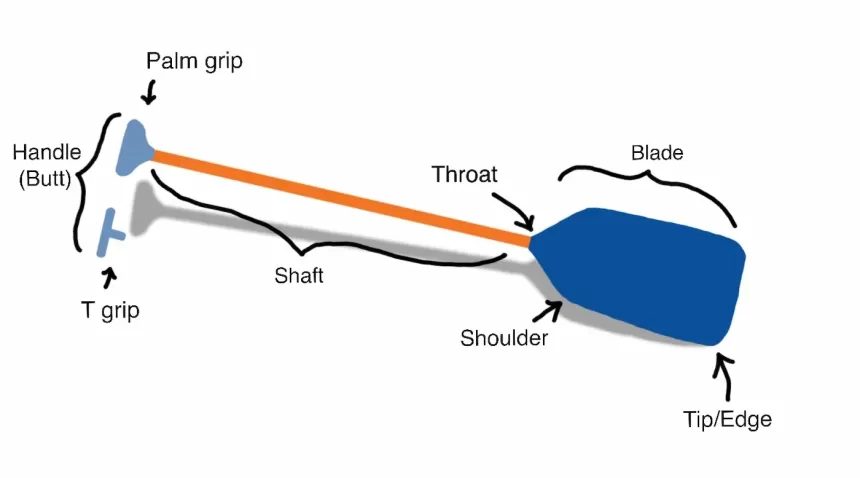
T grip:
A larger horizontal part distinguishes the T grip the paddler can wrap their hands around. This grip provides precise control and a firm grip, making it perfect for activities like whitewater paddling that call for greater maneuverability and control.
You can paddle with greater speed and accuracy with a strong hold on the paddle and the T grip.
Grip ridge:
The grip of certain canoe paddles has a ridge, which is a raised area that aids in keeping your hand in place.
This ridge gives you more grip and keeps your hand from slipping during paddling. It can be especially helpful when paddling in rainy weather, wearing gloves or other canoeing accessories.
Grip throat:
The region where the grip and paddle shaft contact is known as the grip throat. It serves as the place where the grip and shaft diverge. The grip throat design and shape can change depending on the paddle model and manufacturer.
Shaft
Straight Shaft:
The classic canoe paddle design features a straight shaft, which works well for all-around paddling. The straight shaft is often round or somewhat oval in form for the best possible grip comfort.
The blade face is flat on both sides, allowing various bracing and maneuvering strokes. Rivers benefit greatly from the straight shaft’s adaptability and maneuverability.
Bent Shaft:
A bent shaft works best for flatwater paddling or cruising since it positions the blade for optimal effectiveness. The bent shaft makes it a popular option for long-distance paddling because it’s made to provide a more natural grip and lessen wrist stress.
The basic reason for using a bent shaft is to assist a paddler in maintaining good alignment and reducing fatigue by helping them better align their wrist and arm.
The bow paddler, whose only responsibility is to carry the boat forward for most of the paddling voyage, typically uses bent shaft paddles.
Throat:
The paddle’s throat is the shaft portion that comes right before the blade’s shoulder. It is where the shaft and blade come together.
While paddling, your other hand will be primarily on your throat. It is a transition point between the paddle’s shaft and blade, enabling a firm grip and effective body-to-paddle force transfer. Certain paddles may have a minor throat bend to account for the lift in the water.
Shoulder
The canoe paddle’s shoulder is located between the blade and the throat. The spreading portion makes the connection between the throat and the main blade of the paddle.
The shoulder gives the paddle extra strength and stability, enabling faster and more controlled strokes. It serves as a transition between the broader blade and the narrower throat.
Blade
Spoon Blade: A concave spoon blade offers more surface area for the water to press against. This design is preferred for high-performance and competitive paddling since it can deliver more power and efficiency.
Flat Blade: A flat blade has a basic, flat form that offers good control and maneuverability. This design is appropriate for beginners and works well for all-around paddling.
Ottertail Blade: An Ottertail blade’s long, narrow design offers outstanding control and efficiency. This design works well on flatwater lakes and is appropriate for all types of paddling.
Beavertail Blade: The rounded curve of a beavertail blade offers good power and efficiency. This design works well on flatwater lakes and is appropriate for all types of paddling.
Feathered Blade: The angled design of a feathered blade decreases wind resistance and enables quicker paddling. This design is appropriate for windy circumstances and works well for all-around paddling.
Square-tipped Canoe Paddles: Canoe paddles with square tips feature a blade tip that is flat and squared off. This design is suitable for all-around paddling and offers good control and balance.
A spoon or beavertail blade can be your best choice if power and effectiveness are your top priorities. On the other hand, a flat or Ottertail blade would be more appropriate if you need good control and versatility.

Tip:
The very bottom of the blade is where the paddle tip is located. As the paddle piece immediately touches the water, it can offer additional wear and tear defense.
Some paddles have a reinforced tip using materials like Rockgard® or Dynel & Kevlar Pro-Tip to prevent wear and tear.
Taper:
The taper is the steady reduction in breadth and thickness from the shoulder to the blade’s tip. More control and flexibility may be possible with a tapered blade, which can also lessen wind resistance.
Dual taper refers to a paddle’s blade’s tapering on both sides to a thinner edge at the tip. To create a balance between strength and control, adopting a tapered blade is crucial because a narrow blade can lose power.
Types of Canoe Paddles
Recreational Paddles/General Purpose:
Recreational paddles are all-purpose equipment for day trips with family and friends around the cottage, the campsite, or the lake. They typically have flat, basic blade shapes for easy control and movement and are manufactured of lightweight materials.
Touring Paddles:
Paddlers with intermediate to advanced skills can use touring paddles, which are made for longer journeys. They often have a more efficient blade design for increased speed and endurance and are longer and slimmer than recreational paddles.
Expedition Paddles/Canoe Camping Paddles:
Advanced paddlers should use expedition paddles because they are made for multi-day journeys. They typically have a stronger blade design for increased propulsion and control and are longer and wider than touring paddles.
Solo Paddles:
Solo paddles are designed for solo canoeing and are suitable for all skill levels. They usually have a more effective blade form for greater control and mobility and are often shorter and wider than tandem paddles.
Whitewater Paddles:
Whitewater paddles are designed for fast-moving rivers and rapids and are suitable for advanced paddlers. Compared to other paddles, they are often shorter and wider, have a high rocker, and have extra features such as flotation panels for improved control and maneuverability.
Flatwater/Racing Paddles:
Flatwater/racing paddles are designed for speed and are suitable for advanced paddlers. They often have a more efficient blade form for higher canoe speed and endurance and are longer and thinner than other varieties of paddles. A curved shaft may also be in racing paddles to lessen wrist fatigue.
How to Pick a Canoe Paddle?
When picking a canoe paddle, it’s important to consider your height and the paddling you plan to do.
- The paddle should be 6″ shorter than your body height: This is a general rule of thumb that can get you in the correct ballpark.
- Measure in the field: Placing the paddle’s handle in between your legs while seated is a simple technique to take measurements in the field. Make a note of where the blade’s shoulder touched you. Your forehead should be where the shoulder of a straight shaft is, whereas the nose should be where the shoulder of a bent shaft is.
- Set the blade on the top of your foot: Another way to measure is to set the blade on the top. The ideal length is the handle grip resting between your chin and nose.
- Consider the height of your canoe seat: The overall length of the paddle depends on the height of your canoe seat. If you sit higher in the canoe, you may need a longer paddle.
- Use a sizing chart: Many manufacturers provide sizing charts based on your height, and the paddling you plan to do. These charts can be a helpful starting point when choosing a paddle length.
How to Measure Canoe Paddle Size?
- Sizing on the water: While seated inside the canoe, measure the vertical distance from your nose to the water’s surface. This dimension must be equivalent to the distance between a paddle’s grip and the throat, where the shaft and blade meet.
- Sizing in a store: Try holding different paddles to see which size feels most comfortable and efficient. Consider the paddling you plan to do and your preference when choosing a size.
- Using body measurements: Count the distance from the water to the height of your top grasp and your chin. That’s how long the shaft is. Add the blade’s length (20–25 inches, depending on the paddle style).
- Using a reference paddle: If you like a paddle, measure its length and use it as a reference when choosing a new one.
FAQs – how long should a canoe paddle be
How do I know if I need a bent or straight shaft paddle?
The choice between a bent or straight shaft paddle depends on your preference and the paddling you plan to do. Bent shaft paddles are more efficient in the forward stroke and can be more comfortable for long-distance paddling.
Straight-shaft paddles are more versatile and more comfortable for maneuvering and control.
Which material and weight range should I prefer?
Carbon fiber is the lightest and strongest option for paddle material, providing less arm fatigue. Fiberglass is a practical compromise for moderate weight, good strength, and affordability.
As for weight range, a lightweight paddle is generally preferred for reduced fatigue, but remember that lighter paddles often come at a higher cost.
Why the Diameter of the Shaft is important?
The diameter of the shaft is important because it affects the comfort and grip of the paddle. Choosing the proper shaft size for your hands ensures a more comfortable experience on the water and allows you to maintain a lighter grip, reducing fatigue and improving control.
Should I select a larger or smaller blade?
Larger blades provide more power and acceleration with each stroke but require more energy. Smaller blades offer more consistent power over a longer period of time and are suitable for relaxed and efficient paddling. So, in the end, it all depends on your preference.
Should I consider the width of my canoe when sizing a paddle?
Yes, the width of your canoe is an important factor to consider when sizing a paddle. For wider canoes or paddling from the stern (rear seat), consider adding 2 inches to the paddle length to reach the water without excessive leaning.
Is there a difference in paddle length for solo paddling versus tandem paddling?
Yes, there is a difference in paddle length for solo paddling versus tandem paddling. Solo canoes are generally shorter, ranging from 10-16 feet, while tandem canoes are typically 16-18 feet long.
For solo paddling, a shorter paddle is often preferred for better control. When paddling tandem, longer paddles may be necessary to reach the water comfortably from both the bow and stern seats.
Can I adjust the paddle length if I find it uncomfortable or inefficient while paddling?
Yes, you can adjust the paddle length if you find it uncomfortable or inefficient while paddling.
Use a paddle height chart or sizing guide to determine the recommended length based on your height and the paddling you plan to do.
Experiment with different paddle lengths to find the most comfortable and efficient for your paddling style and body proportions.
Consider the width of your canoe or board and the paddling you plan to do. You may need a longer paddle for wider canoes to reach the water comfortably.
Should I consider my paddling style or technique when sizing a canoe paddle?
Yes, considering your paddling style or technique is important when sizing a canoe paddle.
For example, if you have a high-angle paddling style where your top hand is above shoulder height, you may prefer a shorter paddle for a more efficient stroke. A longer paddle may be more suitable if you have a low-angle paddling style with a top hand around shoulder height.
A shorter paddle may provide better control and maneuverability if you have a more aggressive and powerful stroke. A longer paddle may be more suitable for better reach and leverage if you have a more relaxed and efficient stroke.

Passionate freelance writer and certified boat captain, Sam brings his expertise to this pedal boating & Canoeing blog. With a knack for captivating storytelling and in-depth knowledge of boating regulations, he’s here to make your boating experience even more enjoyable and informed.
